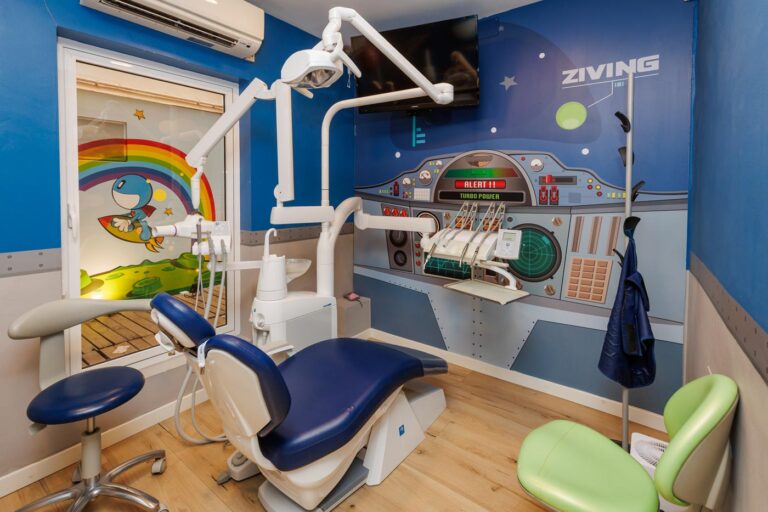Children and adults
ziving is orthodontics

Dental laser
Revolutionary technology to treat dental problems accurately and effectively.
Child Diagnosis
ONLINE
Request your FREE ONLINE diagnosis is very easy.
Use our app and a qualified orthodontic specialist will guide you about your needs and answer your questions.
Make an appointment with our team
You will be attended by the professional team of Ziving Ortodoncia Palma de Mallorca.
We can advise you on any of your needs.
Frequently Asked Questions about Orthodontics in Palma de mallorca
What is orthodontics?
The orthodontics is a branch of dentistry that specializes in the specialized in the diagnosis, prevention and treatment of dental and facial irregularities.. The technical term for this type of problem is “malocclusion”, which means “malocclusion or bad bite”. Our services of orthodontics are formed by highly qualified professionals for the design, application and control of corrective devices. This approach seeks to bring the teeth, lips and jaws into proper alignment, thus achieving perfect facial balance.
What is an orthodontist?
An orthodontist is a professional who focuses on correcting dental and facial alignment problems. His expertise encompasses the diagnosis and treatment of malocclusions, also known as “wrong bite”. They use as treatment of dental braces (such as brackets and clear aligners), to achieve proper alignment of the teeth and improve masticatory function. Consultation with an orthodontist is crucial for those seeking to correct cosmetic or functional problems in their smile and facial structure.
When is orthodontic treatment recommended?
Orthodontics does not have a specific age, it can be beneficial throughout life. beneficial throughout life. However, the ideal time to begin treatment varies according to individual needs. The early evaluation by the pediatric orthodontistis recommended around the age of 7 years old. Treatments are also effective in adolescents and adults. Advances in technology offer more discreet options, such as clear aligners, which are popular with those who wish to correct their smile without compromising esthetics. It is advisable to have check-ups when any oral problem related to the position of the teeth is detected.
How do orthodontic problems occur?
Orthodontic problems, also known as malocclusions, can be caused by a variety of factors. Genetics plays a key role, as hereditary predisposition to certain dental and facial characteristics may contribute to malocclusions. In addition, habits such as thumb sucking, prolonged pacifier use or thumb sucking can affect normal tooth and jaw development. Orthodontic problems are the result of a combination of genetic and environmental factors. An eEarly assessment by an orthodontist can identify these problems and allow for proper treatment planning to correct them.
What are the most common orthodontic problems? Common
- Crowding: Dental misalignment, may arise due to a small dental arch or oversized teeth.
- Protruding Upper Teeth: When the upper teeth protrude beyond their normal position, they may indicate poor dental fit, especially in the posterior area.
- OverbiteOverbite: An overbite occurs when the lower incisor teeth close under the upper incisors and are hidden by them.
- Open bite: An overbite occurs when the lower incisor teeth close below the upper teeth and are hidden behind them. This displacement can affect masticatory function and facial esthetics.
- Dental gapsMissing teeth, small teeth or a dental arch that is too wide can lead to open spaces between teeth, which can cause gum problems.
- Crossbite: In crossbite, the upper teeth fit inside (toward the tongue) of the lower teeth when closing the mouth.
- Protruded lower teeth: The lower teeth may protrude beyond the upper teeth, creating an alignment anomaly. This condition affects the bite and dental harmony.
How do I take care of my teeth with braces?
The patients with braces should avoid eating hard or sticky foods.. They should not chew on pens or pencils, as this may damage the devices. Keeping teeth and braces clean requires more time and more precise toothbrushingand should be performed daily to maintain healthy teeth and gums during treatment. The orthodontist and his assistants usually teach patients the care they should take with their teeth, gums and appliances during treatment: how often they should brush their teeth, how to use additional items to maintain hygiene (dental floss, interproximal brushes, dental rinses, dental showers…) and any other care they should take to maintain excellent oral health.
Why is it important to undergo orthodontic treatment?
Crooked and poorly positioned teeth are difficult to clean and maintain in good health. This can contribute to tooth decay, gum disease and tooth loss. Other unresolved orthodontic problems can result in poor tooth surfaces, inefficient chewing, high stress on gum tissue and the bones that support the teeth, jaw and jaw joint misalignment, which can lead to chronic headaches or pain in the face or neck. If left untreated, orthodontic problems can get worse. The orthodontic treatments are intended to correct and improve the patient’s dental health.
What is the cost of orthodontic treatment?
The cost of orthodontic treatment will depend on many factors, from the complexity of the patient’s problem to the choice of the specific technique to address it. complexity of the patient’s problem to the choice of the specific technique to address it. It will be determined after a diagnosis before starting treatment. In many cases, orthodontists provide flexible payment planning options to suit the patient’s needs.
What is the duration of orthodontic treatment?
The duration of treatment will depend on the depend on the patient, the problem he/she has and his/her cooperation throughout the treatment.usually vary between 12 months and 3 years. Early treatments usually last less time. It is essential to understand that the temporary commitment associated with orthodontic treatment is relatively brief compared to the lasting benefits it provides.
Do orthodontic appliances hurt?
The discomfort caused at the time of the first treatment is normal. After placement, it is common for the teeth to experience sensitivity and pressure for four to five days. This discomfort can be managed with analgesics. During the first weeks of treatment it can also lead to irritation of the lips, cheeks and tongue to jellyfish that adapts to the braces.
Is patient cooperation important in a treatment?
The active collaboration of the patient plays a fundamental role in the success of any dental treatment. To achieve the desired results the patient must maintain good oral hygiene, use the appliances correctly and attend scheduled appointments. This collaboration not only improves treatment results, but also contributes to the prevention of future dental problems. Damaged or broken devices may prolong the duration of treatment and have undesirable effects.








